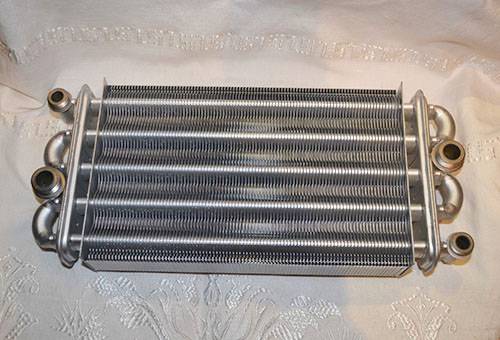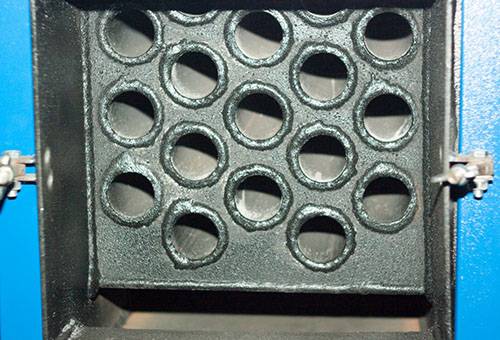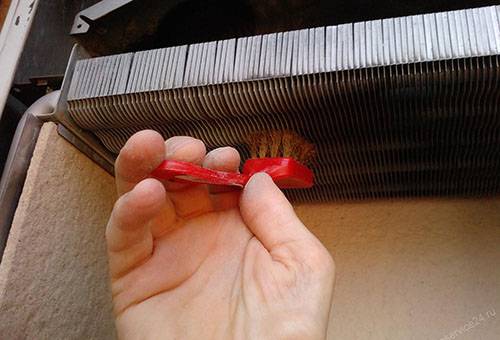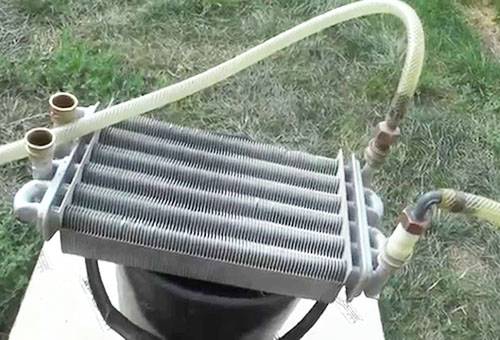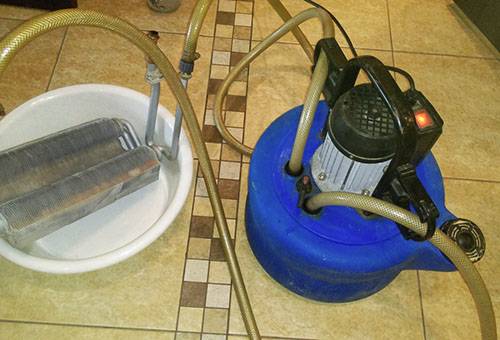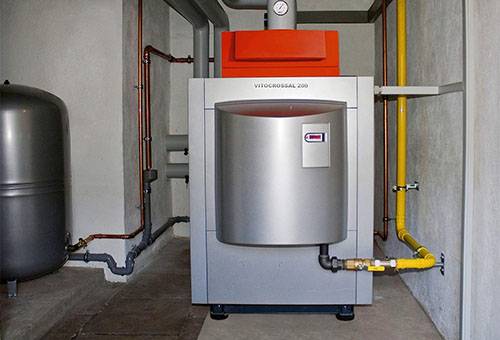How to clean the gas boiler and flush the heat exchanger?
Content:
Cleaning the boiler is a mandatory procedure that must be performed regularly. In this case, you need to know how to clean the gas boiler from soot and scale. Scale is collected in the passages of the heat exchanger, and soot - in the flue ducts of the boiler itself and the chimney. Thus, in order to maintain the heating equipment in working condition, it is necessary to clean both the heat exchanger, and the smoke channels, as well as the gas duct and burner.
How to clean the heat exchanger?
Cleaning the heat exchanger depends on its design and on what water is used in the system: prepared - with special additives - or unprepared.
By design, the heat exchanger can be one of three types:
- bithermic;
- lamellar;
- fire tube.
Lamellar subdivided into two types - primary and secondary (for heating water). The heat pipe heat exchanger is installed in floor boilers, and the bithermic heat exchanger is installed in compact mounted or floor models.
Cleaning can be done in the following ways:
- mechanical;
- chemical;
- electric discharge;
- hydrodynamic
Tip
Maintenance of gas equipment, including boilers, should be performed by specialists with the appropriate education. If you do not have enough technical skills, it is better to invite a wizard.
How to clean the fire tube heat exchanger of a single-circuit boiler?
Cleaning floor boilers with a fire tube heat exchanger differs from the same procedure for attachments. Here, for the procedure, the heat exchanger is not removed, but only access is provided to it.
To perform the work you will need the following tools:
- open end wrenches;
- metal brush ruff;
- hand brush for metal;
- screwdriver;
- natural nap brush or nylon brush.
The first required action is to turn off the gas supply valve. Next, you need to perform three stages of work - providing access to the heat exchanger, cleaning parts, assembling the boiler. Disassembly / assembly steps vary by model. How to clean the boilers model MAYAK - 12 KS, you can see in detail in the video.
Double-circuit boiler cleaning
For boilers with a circuit for heating water, it is mandatory to flush the secondary heat exchanger from scale inside. Moreover, it needs to be cleaned more often, since a stream of unprepared water passes through it and hardness salts (mineral deposits) are actively deposited on the walls. The same goes for bithermic heat exchangers. Double-circuit boilers are cleaned in two stages. The first is the mechanical cleaning of the outer surface of parts and chimneys from soot, the second is a chemical, hydrodynamic or electric discharge flushing from scale.
Mechanical cleaning of plate heat exchangers
To clean the boiler from soot without removing the heat exchanger. To do this, it is enough to remove the cover, arm with a hard nylon brush and close the gas nozzles so that dirt does not get there. The whole process is clearly shown in the video:
If soot has stuck to the surface and is not removed by brushing, then the heat exchanger is removed and soaked in special washing solutions for several hours. Such products are on sale in a wide range, as an example, Fauch and MAZBIT +. But you can also use household chemicals - gels for cleaning grills, ovens.
Before disassembling the boiler, it is necessary to disconnect it from the gas, and the igniter - from electricity. In addition, it is necessary to drain the water from both circuits and the expansion tank. The second heat exchanger is removed first, it is located immediately behind the boiler cover. The primary (main) removal is more problematic, since you have to disassemble the combustion chamber.
How to clean the inner surfaces?
Washing the inner surface of a plate, fire tube or bithermic heat exchanger is possible only with the help of special equipment.
- High pressure pump - hydrodynamic flushing. Used to remove small deposits. Advantages - speed of the procedure and the possibility of cleaning without removing the heat exchanger.
- Booster (acid resistant pump) - acid (chemical) flushing. Removes even old scale. Benefits - removes scale that cannot be removed by other methods. Disadvantages - with the wrong selection of reagents (acids and neutralizers) reduces the life of the heat exchanger.
- Streamer complex for electric discharge cleaning. Used to remove scale of any strength. Advantages - the metal of the heat exchanger is not destroyed, a high degree of purification is provided. Disadvantages - noise and duration of the procedure.
Of all these methods, only chemical cleaning is possible at home, since the factory booster can be replaced with a low-pressure pump. The rest of the equipment is both expensive and voluminous, so that such washing of the boilers can only be done by service centers.
Chemical cleaning
With a booster, flushing can be done independently. You can make a booster with your own hands - this is a pump and a capacity of 10 liters with two hoses. In order for the procedure to help remove scale, but not damage the metal surface, it is important to choose the right acid. If the boiler is cleaned regularly, there is little deposits on the pipes, then the best solution would be to use citric acid. The concentration of the solution is up to 200 g of acid per 5 liters of water.
If the scum is old or unprepared water with a high content of minerals (hard water) is used, it is necessary to take more radical means - compounds based on phosphoric, sulfuric or hydrochloric acid. Using a hydrochloric acid solution without corrosion inhibitors is not recommended, as this can lead to equipment damage.
After acid treatment, the heat exchanger must be flushed with a neutralizer. The alkaline composition is selected based on the acid used. For example, after citric acid, ordinary baking soda is quite suitable. If a flushing fluid is bought, it is best to purchase a neutralizer immediately: usually firms that produce acidic compounds offer alkaline ones to neutralize it.
Flushing video:
How often do you need to clean the boiler?
The technical documentation for the boiler indicates how often it is necessary to carry out its maintenance. For closed circuits with the addition of reagents (single-circuit heating boilers), cleaning is required less often. It can be performed once every 2-3 years. The bithermic and secondary heat exchanger must be flushed every year, and under difficult operating conditions (“poor” water composition) - twice a year.
Signs that the boiler is in urgent need of cleaning:
- the boiler is slowly gaining temperature;
- insufficient traction;
- the burner does not light or burn poorly;
- with the same gas consumption, heat transfer is less;
- traces of soot or partially burnt paint in the area of the viewing window.
Do not neglect preventive measures, because the result of this can be not only broken equipment, but also a threat to the safety of all residents of the house. Clogged flue ducts and pipes with growths inside can cause serious accidents.
